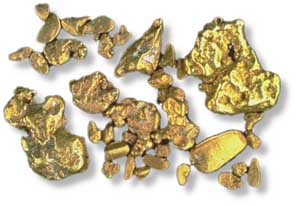Mendocino Redwood Company
| Golden Dreams |
|
Strange as it may sound, those embarking for the California gold fields often announced that they were off "to see the elephant." The phrase, in use even before the gold rush, captured the anticipation and circus-like atmosphere of the whole adventure. The story behind it varies a bit, but basically the tale is about a farmer and a circus wagon. A farmer heads to market with his wagon fully loaded. Enroute he sees a circus parade, with an elephant at the front of the line. While the farmer was dazzled, his horses were terrified. Bolting, the horses overturn the wagon and the farmer's produce spills across the road. Scarcely ruffled, the farmer says, "I don't give a hang for I have seen the elephant." (Levy xvi). Many a 49er must have returned from the California rivers and streams with empty pockets and a feeling that all they had seen was the elephant's backside! As a matter of fact, the two men most associated with the discovery of gold in California—James Marshall and John Sutter—died poor and bitter. In Sutter's case, his mill workers ran off to look for gold, squatters over-ran his 50,000 acres near Sacramento and even killed many of his 13,000 cattle. As a final blow, his Mexican land grant was contested in a federal court. He died bankrupt and alcoholic in a Pennsylvania hotel room having failed, as have many men after him, to get a timely and favorable response from the U.S. Congress. "By this sudden discovery of the gold, all my great plans were destroyed," Sutter said. "Instead of being rich, I am ruined" (Kowalewski, 52). The new immigrants to California came not only from other states in the Union but other countries as well, like Australia, Chile, and China. For most of the 49ers as they were called, California was a long way from home—even if you started on US soil. If you were from “back East,” there was the sea route around the tip of South America, a trip of about 5 months. If you were from the central prairie there was the Oregon-California trail by foot or wagon—a shorter distance but not faster. Either way there was only so much the average family or individual could afford to haul. All the new California residents
needed housing, furniture, clothing, food, and, of course, entertainment.
San Francisco, in particular, was filled with ready-made consumers.
In fact, the first self-made California millionaire was not a gold
miner. It was Sam Brannan, originally a Maine Yankee and later a
San Francisco newspaper publisher and "chain store" owner
who sold the sweating gold miners shovels, picks, whiskey, flour,
and anything else he could lay his hands on. Even today there
is money to be made from the old 49ers. In
2005 a rare Gold Rush-era coin (a "Quarter Eagle"), owned
by a descendant of Chinese immigrants who toiled in those California
gold fields, sold for $253,000 at a Beverly Hills auction! As for
Sam Brannan, asked by an emissary of Brigham Young whether he intended
to fulfill his duty to the Mormon church and tithe, Brannan reportedly
replied:: "I'll give up the Lord’s money when he sends
me a receipt signed by the Lord”! Author: DMS |
|
Secondary Sources Brands, H.W. The Age of Gold: The California Gold Rush and the New American Dream. New York: Doubleday, 2002. Egenhoff, Elizabeth L. The Elephant as They Saw It. California Journal of Mines and Geology, October 1949. Holliday, J.S. The World Rushed In: The California Gold Rush Experience. New York: Simon Schuster, 1981. Kowalski, Michael, ed. Gold Rush: A Literary Exploration.Berkeley, CA: Heyday Books, 1997. Layton, Thomas N. The Voyage of the Frolic, Stanford University Press, 1997. Joann Levy. They Saw the Elephant: Women in the California Gold Rush. Archon Books, 1990.
|
Mendocino Redwood Company - Ukiah, California
 "The
men and times are rich, golden rich" (Layton, 123). This is
how one businessman in 1849 described what would come to be called
in the history books the California Gold Rush.
Before March 15, 1848—when The Californian first
reported the story about the discovery of gold at Sutter's Mill
two months earlier—the population of San Francisco was under
1000 people. By 1850, the year California officially became a state,
the population of the golden city had exploded to 36,154. Estimates
are that more than 300,000 people came to California between 1848
and 1854.
"The
men and times are rich, golden rich" (Layton, 123). This is
how one businessman in 1849 described what would come to be called
in the history books the California Gold Rush.
Before March 15, 1848—when The Californian first
reported the story about the discovery of gold at Sutter's Mill
two months earlier—the population of San Francisco was under
1000 people. By 1850, the year California officially became a state,
the population of the golden city had exploded to 36,154. Estimates
are that more than 300,000 people came to California between 1848
and 1854.